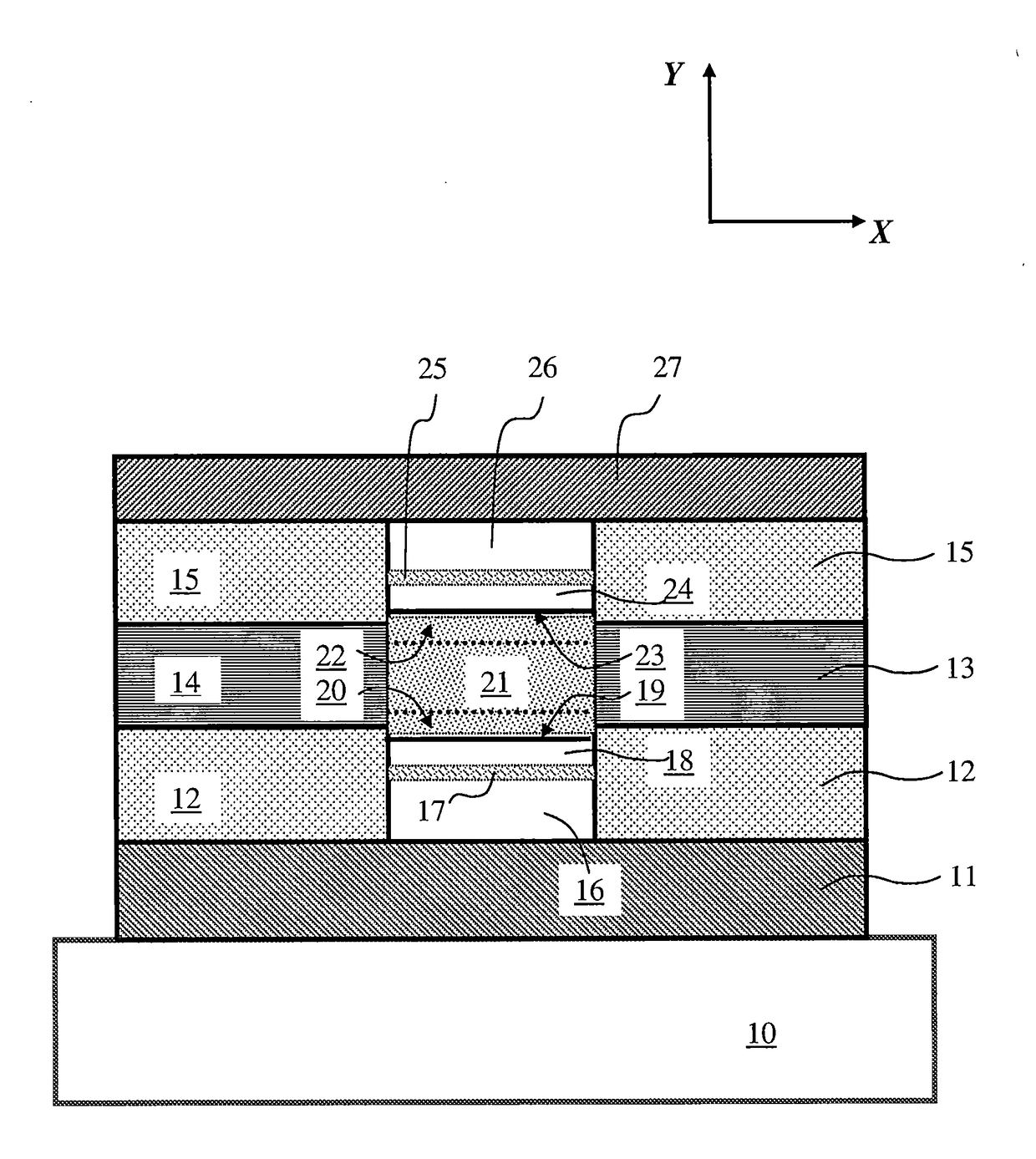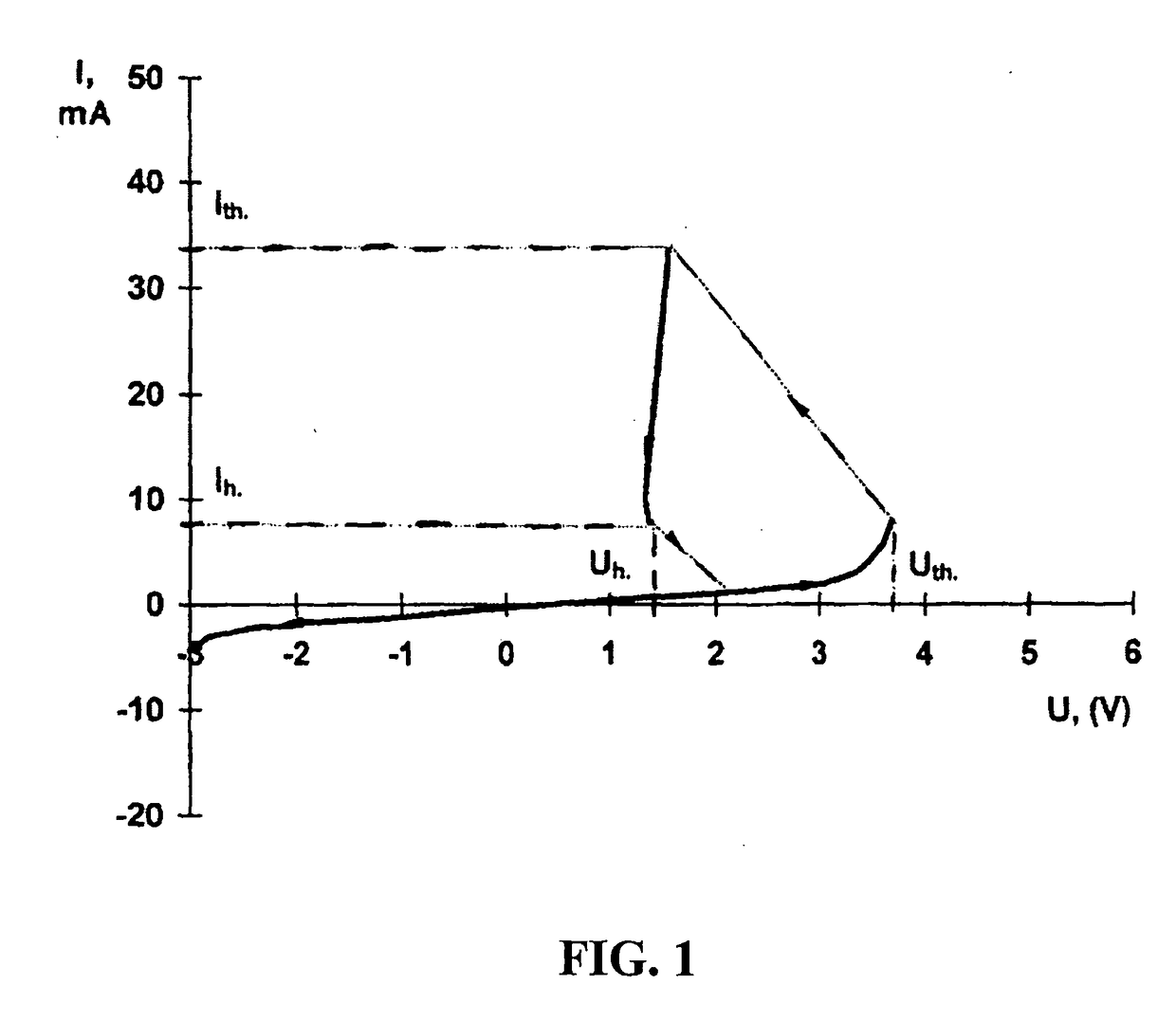SEMICONDUCTOR MEMORY DEVICES FOR USE IN ELECTRICALLY ALTERABLE READ ONLY MEMORY (ROM) AND SEMICONDUCTOR THIN FILM DEVICES (SPINTRONS and SPIN-ORBITRONS)
- Summary
- Abstract
- Description
- Claims
- Application Information
AI Technical Summary
Benefits of technology
Problems solved by technology
Method used
Image
Examples
example 1
[0098]As shown in FIG. 11, the memory device is formed on an insulator layer 10 which may or may not be a semiconductor substrate. The structure includes an insulator substrate 10, a lower electrode 11 that includes a conductive layer formed from Molybdenum (Mo), a lower Si3N4 insulating layer 12, an offset electrode 13 (or electrodes 13, 14) that includes a conductive layer (or layers) formed from Aluminum (Al), an upper Si3N4 insulating layer 15, a chalcogenide memory material contained in the pore region of the device, and an upper electrode 27 that includes a conductive layer formed from Molybdenum (Mo). The chalcogenide memory material has a stacked structure in which a Tellurium layer (central area) having an appropriate concentration of electrically active donor impurities is placed between two memory layers (lower 19 and upper 23). In the embodiment of FIG. 11, the two interfaces of chalcogenide films, Te—SnTe or Te—GeTe, are used as memory layers 19 and 23 respectively.
[009...
examples 2 and 3
[0114]In these examples, devices having an asymmetric design were fabricated according to the technological process described with respect to Example 1 hereinabove. In the asymmetric design, upper insulating layer 15 and lower insulating layer 12 were of different thicknesses. More specifically, thicknesses of the insulating layers 12 and 15 are such that the offset electrodes 13 and 14 are located in closer spatial proximity to lower memory layer 19 than to upper memory layer 23. The asymmetric placement of electrodes 13 and 14 facilitates the creation of memory cells with effects such as interfacial superconductivity and interfacial magnetization (a current modulation of nonequilibrium magnetization or spin transistor effect) in semiconducting chalcogenide superlattices occurring at room temperature.
example 2
Spin-Orbitrons
[0115]In this example, a layer 21 of Tellurium with a high concentration of mobile positively charged ions is the source of electrically active donor impurities such as the rare earth element Yttrium (Y) and Copper (Cu), or impurities such as iron (Fe) migrating into layers 20 and 22. The amount of the two donor impurities (e.g., Y and Cu) in ion source layer 21 is preferably on the order of approximately 25±10 percent by atomic weight. The content of Copper in the layer 21 is preferably on the order of 4±5 percent by atomic weight. The dielectric layers 17, 25 are used as additives or as the sources of negatively charged impurities in both chalcogenide alloys 18, 24. The thickness of dielectric layers 17, 25 are in the range of 20.0-40.0 nm. The layers 17, 25 of dielectric containing Oxygen and Cuprum (CuO) or Oxygen, Cuprum and Barium (BaCuO2) or even more complex dielectrics, e.g., Lead, Magnesium, Oxygen, Cuprum and Barium {(Pb2Mg2)Ba2Cu9O15} are necessary for the ...
PUM
 Login to View More
Login to View More Abstract
Description
Claims
Application Information
 Login to View More
Login to View More - R&D
- Intellectual Property
- Life Sciences
- Materials
- Tech Scout
- Unparalleled Data Quality
- Higher Quality Content
- 60% Fewer Hallucinations
Browse by: Latest US Patents, China's latest patents, Technical Efficacy Thesaurus, Application Domain, Technology Topic, Popular Technical Reports.
© 2025 PatSnap. All rights reserved.Legal|Privacy policy|Modern Slavery Act Transparency Statement|Sitemap|About US| Contact US: help@patsnap.com



